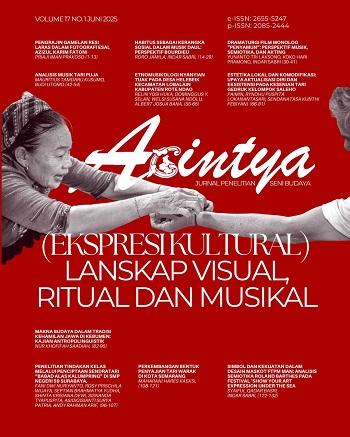ANALYSIS OF PUJA DANCE MUSIC
DOI:
https://doi.org/10.33153/acy.v17i1.7252Keywords:
analysis, music, Puja DanceAbstract
This study aims to examine textually and contextually the Puja Dance Music presented in the ritual of the Puja Bakti Agung Asadha. This research was carried out qualitatively with data collection methods such as document studies, observation of performance recordings and interviews. The analysis in this study relies on a formal aesthetic understanding for multi-layered analysis and the drawing of conclusions presented descriptively. The results obtained from the results of the analysis are that Puja Dance Music textually functions as a dance accompaniment that frames the dramatic presentation of the Puja Dance performance in a liturgical context. Contextually, the music works of the Puja Dance are arranged as a form of contribution to the development of religious performance arts in the country.
Downloads
References
Aasen, S. (2021). Crossmodal Aesthetics: How Music and Dance Can Match. In Philosophical Quarterly. https://doi.org/10.1093/pq/pqaa049
Clemente, A., Pearce, M. T., & Nadal, M. (2021). Musical Aesthetic Sensitivity. Psychology of Aesthetics, Creativity, and the Arts. https://doi.org/10.1037/aca0000381
Gürvine, T., & Rahmat, A. (2015). Sinkretisme Budaya Jawa–Buddha dalam Tari Ritual. Seni Tradisi, 5(2), 134–147.
Harvey, P. (2013). An Introduction To Buddhism: Theaching History and Practices. In Cambridge Universities Press (Second). Cambridge University Press. https://doi.org/10.1176/pn.38.2.0027a
Holm, D. (2005). Buddhist Ethics: A New View from the Pali Canon. Routledge.
I Wayan Diana Putra. (2025). Na Saji, New Balinese Karawitan Creation Method. Acintya : Jurnal Penelitian Seni Budaya, 16(2), 232–240. https://doi.org/10.33153/acy.v16i2.6765
Kashyap, T., Doshi, A., & Arora, K. (2022). Buddhist Psychology Intersects with Dance Movement Therapy. Creative Arts in Education and Therapy. https://doi.org/10.15212/CAET/2021/7/17
Liu, C. (2018). Reciting, Chanting, and Singing: The Codification of Vocal Music in Buddhist Canon Law. Journal of Indian Philosophy. https://doi.org/10.1007/s10781-018-9360-8
Miller, G. W. (2017). Dancing with Dharma: Essays on Movement and Dance in Western Buddhism. Journal of Dance Education, 17(4), 162–163. https://doi.org/10.1080/15290824.2017.1283579
Putro, R. L. U. (2015). Fungsi Kidung Dalam Bojana Ekaristi. Dewa Ruci: Jurnal Pengkajian Dan Penciptaan Seni, 10(1), 1–12. https://doi.org/10.33153/dewaruci.v10i1.2139
Rambelli, F. (2021). The dharma of music: Gagaku and buddhist salvation in medieval Japan. Japanese Journal of Religious Studies. https://doi.org/10.18874/jjrs.48.1.2021.45-71
Riggle, N. (2024). Autonomy and aesthetic valuing. Philosophy and Phenomenological Research. https://doi.org/10.1111/phpr.13045
Sheppard, A., & Broughton, M. C. (2020). Promoting wellbeing and health through active participation in music and dance: a systematic review. International Journal of Qualitative Studies on Health and Well-Being, 15. https://api.semanticscholar.org/CorpusID:215405693
Strong, J. (2009). The Buddha: a beginner`s guide. Oxford: One World Publications.
Williams-Oerberg, E. (2021). Buddhist ritual as “Connectionwork”: Aesthetics and technologies of mediating religious belonging. Numen. https://doi.org/10.1163/15685276-12341637
Downloads
Published
How to Cite
Issue
Section
License
Copyright (c) 2025 mauritius tamdaru Kusumo, Budi Utomo

This work is licensed under a Creative Commons Attribution 4.0 International License.
Author continues to retain the copyright if the article is published in this journal. The publisher will only need publishing rights




